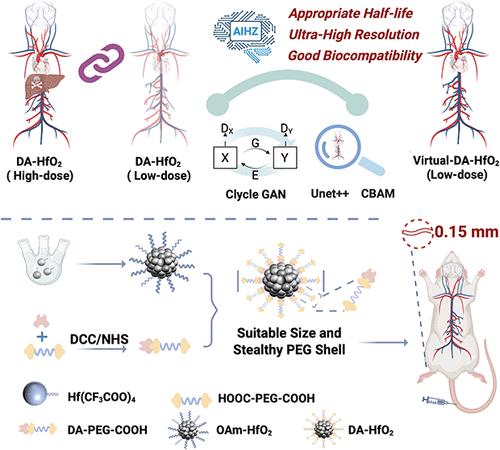Artificial Intelligence-Assisted Low-Dose High Atomic Number Contrast Agent for Ultrahigh-Resolution Computed Tomography Angiography
IF 16
1区 材料科学
Q1 CHEMISTRY, MULTIDISCIPLINARY
引用次数: 0
Abstract
Achieving high resolution while minimizing contrast agent dosage remains a key goal, yet a major challenge in contrast-enhanced computed tomography (CT) imaging. Herein, we propose an artificial intelligence-assisted low-dose high atomic number contrast agent for ultrahigh-resolution CT imaging. As a proof of concept, high-quality PEGylated hafnium oxide nanoparticles (DA-HfO2 NPs) are synthesized, exhibiting superior X-ray attenuation, high hafnium content (36%), excellent water solubility, appropriate hydrodynamic size (13.5 nm), and prolonged circulation half-life (161.9 min). High-dose DA-HfO2 NPs enable extended ultrahigh-resolution vascular imaging with a spatial resolution of 0.15 mm and a time window of at least 60 min. More importantly, by integrating artificial intelligence, the low-dose contrast agent (at 25% of the standard dose) achieves imaging quality comparable to that of the high-dose agent in both contrast density and spatial resolution, while simultaneously enhancing biosafety. This strategy enables high-resolution imaging at reduced contrast agent doses and offers a promising approach for sensitive and safe CT angiography.

用于超高分辨率计算机断层血管造影的人工智能辅助低剂量高原子序数造影剂
在减少造影剂剂量的同时实现高分辨率仍然是一个关键目标,但这也是对比度增强计算机断层扫描(CT)成像的主要挑战。在此,我们提出了一种人工智能辅助的用于超高分辨率CT成像的低剂量高原子序数造影剂。作为概念证明,合成了高质量的聚乙二醇化氧化铪纳米粒子(DA-HfO2 NPs),具有优异的x射线衰减,高铪含量(36%),优异的水溶性,合适的水动力尺寸(13.5 nm)和延长的循环半衰期(161.9 min)。高剂量DA-HfO2 NPs可实现扩展的超高分辨率血管成像,空间分辨率为0.15 mm,时间窗至少为60分钟。更重要的是,通过整合人工智能,低剂量造影剂(标准剂量的25%)在对比度密度和空间分辨率上都达到了与高剂量造影剂相当的成像质量,同时增强了生物安全性。该策略可以在减少造影剂剂量的情况下实现高分辨率成像,并为敏感和安全的CT血管造影提供了有前途的方法。
本文章由计算机程序翻译,如有差异,请以英文原文为准。
求助全文
约1分钟内获得全文
求助全文
来源期刊

ACS Nano
工程技术-材料科学:综合
CiteScore
26.00
自引率
4.10%
发文量
1627
审稿时长
1.7 months
期刊介绍:
ACS Nano, published monthly, serves as an international forum for comprehensive articles on nanoscience and nanotechnology research at the intersections of chemistry, biology, materials science, physics, and engineering. The journal fosters communication among scientists in these communities, facilitating collaboration, new research opportunities, and advancements through discoveries. ACS Nano covers synthesis, assembly, characterization, theory, and simulation of nanostructures, nanobiotechnology, nanofabrication, methods and tools for nanoscience and nanotechnology, and self- and directed-assembly. Alongside original research articles, it offers thorough reviews, perspectives on cutting-edge research, and discussions envisioning the future of nanoscience and nanotechnology.
 求助内容:
求助内容: 应助结果提醒方式:
应助结果提醒方式:


